
Reg. Trib. Milano n. 418 del 02.07.2007
Direttore responsabile: Elisabetta Brunella
![]()
![]()
International Edition No. 60 - year 5 - 8 April 2010

***
Digital projection: topics
and talks from the seventh edition of the course
“DigiTraining Plus: European Cinemas Experiencing New Technologies”
(Helsinki, 17-21 February 2010)
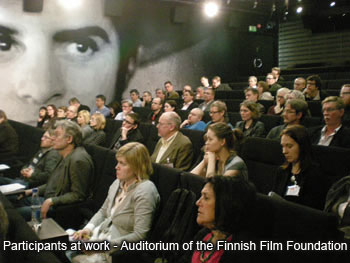 Models
and practices for the financing of the digital transition, either already
established or being experimented, new developments and projects in the
area of content, and much more. At the seventh edition of “DigiTraining
Plus European Cinemas Experiencing New Technologies”, held
by MEDIA Salles in Helsinki, at the Finnish Film Foundation, from 17 to
21 February 2010, the over 60 professional players from 13 different countries
visited some of the cinemas most in the avant-garde in terms of using
the new technologies and were able to come to grips with new developments
in the sector, thanks also to focuses on some nations where digital is
in rapid expansion, such as Russia, or where interesting economic models
have been adopted or are being launched, such as Norway or the Netherlands.
Models
and practices for the financing of the digital transition, either already
established or being experimented, new developments and projects in the
area of content, and much more. At the seventh edition of “DigiTraining
Plus European Cinemas Experiencing New Technologies”, held
by MEDIA Salles in Helsinki, at the Finnish Film Foundation, from 17 to
21 February 2010, the over 60 professional players from 13 different countries
visited some of the cinemas most in the avant-garde in terms of using
the new technologies and were able to come to grips with new developments
in the sector, thanks also to focuses on some nations where digital is
in rapid expansion, such as Russia, or where interesting economic models
have been adopted or are being launched, such as Norway or the Netherlands.
Hosting the course this year was a country
that is very active in the shift to the new technologies. Thanks to a
public investment of 2 million euros for the digitization of the entire
cinema chain in 2009, Finland can, in fact, be considered a “digital
laboratory”, with as many as 48 digital theatres, or 15% of the
total, at January 2010.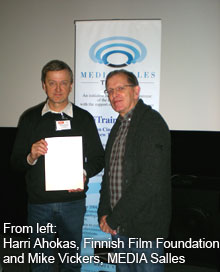 The merit of a strategy of public funding, explained as follows by Leena
Laksonen, consultant for the Ministry of Education and Culture,
who spoke at the course: “It is evident, that most of the cinemas
in Finland must be digitised with the help of state aid and some even
by nearly hundred percent of public subsidy”. This is because: “If
the investments were made only by the box office gross, there would be
less than ten cinemas digitised in Finland. And we have around 180 cinemas
in a hundred different localities. As a result, we would probably lose
about ninety percent of cinemas if we did not have any public funding”.
The merit of a strategy of public funding, explained as follows by Leena
Laksonen, consultant for the Ministry of Education and Culture,
who spoke at the course: “It is evident, that most of the cinemas
in Finland must be digitised with the help of state aid and some even
by nearly hundred percent of public subsidy”. This is because: “If
the investments were made only by the box office gross, there would be
less than ten cinemas digitised in Finland. And we have around 180 cinemas
in a hundred different localities. As a result, we would probably lose
about ninety percent of cinemas if we did not have any public funding”.
It was public financing – national
and European – that was the central issue in several talks: Kerstin
Degerman, Head of the MEDIA Desk Finland, announced
that the intervention by the 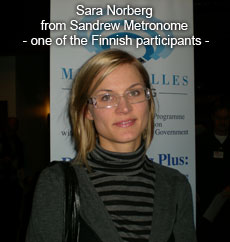 MEDIA
Programme, the launch of which is foreseen for next summer, will mainly
be directed at helping small-scale exhibitors in the adoption of digital
equipment. As regards the films themselves, Harri Ahokas,
Head of Domestic Distribution at the Finnish Film Foundation,
stated that, “public funding is money with ethics and a moral,”
and for this very reason, “making room for various types of domestic
productions in programming is part of the ethics of public financing.”
Along the same lines, Jonathan Davis, consultant for
audiovisual policies, who recalled the declaration signed last September
by the national institutions dealing with the cinema in Europe, according
to which the main objective of public aid in the digital transition –
which must take place as rapidly and efficiently as possible – is
to support the diversification of offer in cinemas.
MEDIA
Programme, the launch of which is foreseen for next summer, will mainly
be directed at helping small-scale exhibitors in the adoption of digital
equipment. As regards the films themselves, Harri Ahokas,
Head of Domestic Distribution at the Finnish Film Foundation,
stated that, “public funding is money with ethics and a moral,”
and for this very reason, “making room for various types of domestic
productions in programming is part of the ethics of public financing.”
Along the same lines, Jonathan Davis, consultant for
audiovisual policies, who recalled the declaration signed last September
by the national institutions dealing with the cinema in Europe, according
to which the main objective of public aid in the digital transition –
which must take place as rapidly and efficiently as possible – is
to support the diversification of offer in cinemas.
If public intervention is decisive in the
start-up phase, all the players in the cinema chain need to be involved
for it to become effective: Guillaume 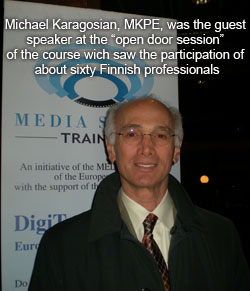 Thomine-Desmazures
and Fabrice Testa explained the economic model of transition
to digital proposed by two European leaders in the field of digital services,
respectively Arts Alliance Media and XDC.
Thomine-Desmazures
and Fabrice Testa explained the economic model of transition
to digital proposed by two European leaders in the field of digital services,
respectively Arts Alliance Media and XDC.
A lot of time and interest was devoted
to content, which, thanks to digital, seems to be increasing and also
becoming more varied. Novelties and new trends were described by the leading
players in this  sector:
from opera “served up for the cinema” by the most prestigious
European opera-houses (Erik Hamre, Emerging Pictures),
to the 3D events offered live via satellite, (Walter Munarini,
Open Sky), right up to the creation of authentic online communities,
for which the movie theatre has become the meeting point, as in the “Digital
Alfie” project, approved in January 2010 with the support
of the MEDIA Programme, which was outlined by Frauke Feuer,
of Peaceful Fish. This initiative proposes supplying
theatres with the digital tools for building an online community and responding
better to their audiences’ expectations.
sector:
from opera “served up for the cinema” by the most prestigious
European opera-houses (Erik Hamre, Emerging Pictures),
to the 3D events offered live via satellite, (Walter Munarini,
Open Sky), right up to the creation of authentic online communities,
for which the movie theatre has become the meeting point, as in the “Digital
Alfie” project, approved in January 2010 with the support
of the MEDIA Programme, which was outlined by Frauke Feuer,
of Peaceful Fish. This initiative proposes supplying
theatres with the digital tools for building an online community and responding
better to their audiences’ expectations.
Of particular significance was the focus
on some countries in which digital is expanding rapidly: Oleg
Berezin, Managing Director of the Russian Nevafilm,
described the rapid development of the new technology in Russia (the number
of digital screens rose from 91 to 353 in just one year and 99% of them
are also equipped for 3D) and Marieke Jonker, of Amstelfilm,
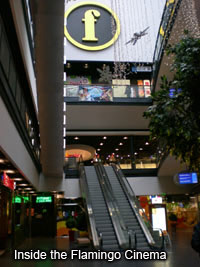 presented
the situation in Holland, observed through the eyes of an independent
distributor who considers digital a chance to improve the circulation
of European and art-house movies.
presented
the situation in Holland, observed through the eyes of an independent
distributor who considers digital a chance to improve the circulation
of European and art-house movies.
A great many sessions but also visits to theatres in the avantgarde of digital projection, such as the Biorex, one of the most important in Finland, situated in Espoo, a few kilometres from the capital – in the Sello shopping mall – and the Flamingo Cinema of Vantaa, a complex belonging to Finnkino, where 2 of the 6 theatres are equipped with 3D digital technology. Amongst the models of excellence, there is also a single-screen cinema: the BioGrand in Tikkurila – founded in 1939, rebuilt in 1984 and fitted with a 3D digital projector since the end of 2009.
Lastly, a glance at the future: Tommi
Rissanen, consultant for Digital Media Finland, attempted a 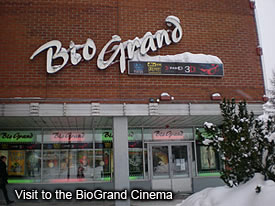 sortie
into the next decade. From which a positive picture emerged. Thanks, according
to Rissanen, to three keywords: “technology, interaction, experience.”
sortie
into the next decade. From which a positive picture emerged. Thanks, according
to Rissanen, to three keywords: “technology, interaction, experience.”
The talks and presentations given during the course – moderated by Tony Williams, more than 40 years of career in the sector, and introduced by Tero Koistinen, Director General of the Finnish Chamber of Films and member of the MEDIA Salles Executive Committee - are now available online (www.mediasalles.it/training/training.htm). Even those who were unable to take part can now become acquainted with the content of the course which, organized by MEDIA Salles with the support of the European Union and the Italian Government, is still the MEDIA Programme’s only training initiative devoted to digital technologies from the cinemas’ point of view. At the website it is possible to consult the recent statistical data collected by MEDIA Salles on the development of digital projection and the European cinema market, which was presented during the course by Elisabetta Brunella, Secretary General of MEDIA Salles. The figures – used by the course participants to find their bearings on today’s complex scenario – record a boom in the spread of digital screens in the first few months of last year, when the increase in screens with DLP Cinema or 4K technology over the six-month period touched on 70%. To find out whether this trend is confirmed in the second half of 2009, we shall have to wait until next May in Cannes, during the 63rd Film Festival, when MEDIA Salles will be presenting the statistical data on digital cinemas and screens updated at first January 2010.
Until we meet again in Cannes!
Talks and presentations are published in the section “DigiTraining Plus: European Cinemas Experiencing New Technologies” on the MEDIA Salles website (www. mediasalles.it)
MEDIA Salles’ contacts and address
MEDIA Salles
Piazza Luigi di Savoia, 24 – 20124 Milano - Italy
Tel.: +39.02.6739781 – Fax: +39.02.6690410
E-mail: infocinema@mediasalles.it
Sito web: www.mediasalles.it